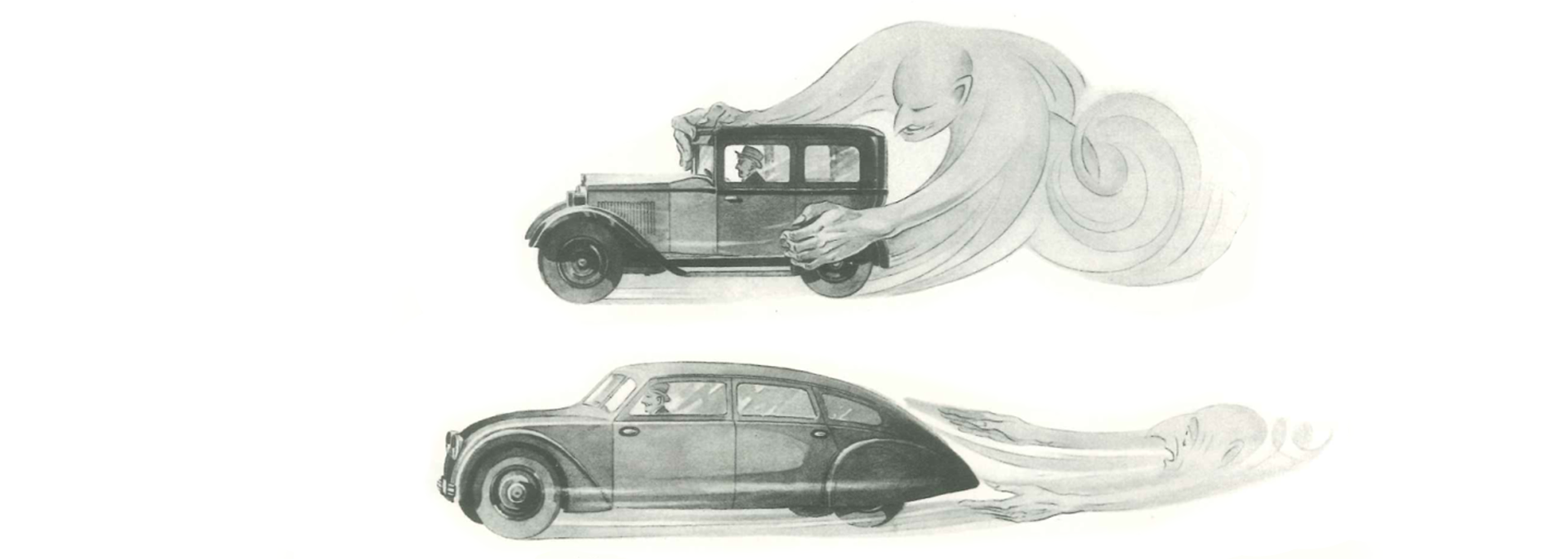III - Friction #
Friction; Because All Good Things Must Come to an End. #

Wake turbulence behind an aircraft. Photo courtesy of David Birkbeck
Introductory Thoughts #
Energy is a finite quantity in the universe. It can manifest in many different ways, but it’s always conserved. Unfortunately, that’s not to say it’s always useful, as friction acts to decay its utility over time. This has important consequences in aerodynamics.
Another Look #
The previous article discussed Bernoulli’s Principle and how it relates static & dynamic pressure if total pressure is constant. Unfortunately, Bernoulli’s principle represents an ideal that, while sometimes close, is not actually true.
Heat #
To understand why, take a step back. To explain ‘work’, a block being pushed is referenced in the previous article. What hasn’t been discussed is that, when being pushed, the block does work on the ground, and the ground does work on the block. The result is friction, which converts some of the energy in the system into heat. Friction is why a constant force needs to be applied to keep the block moving. Without it, one small touch and the block slides away forever.

This also occurs in fluid flow. The flow does work on whatever it’s flowing around, and that object does work on the flow. Regardless of the speed of the outer flow, friction acts to decelerate the velocity of the flow to zero near the surface. This is due to it not being possible for a fluid to ‘slip’ past a surface, as the surface ‘grabs’ onto the flow and slows it down. Going outwards, there’s a transition of velocity back out to the freestream speed. This collection of slow fluid near the surface, flow effected by friction, is termed the boundary layer.

The size of the B.L is greatly exaggerated for the sake of visual clarity.
| Point | Behavior |
|---|---|
| 1. | The boundary layer initially starts off as orderly. |
| 2. | But very quickly it becomes chaotic. |
The longer the flow interacts with the body, the more the effect of friction compounds, thickening the boundary layer along the length of the object. The boundary layer represents a total pressure loss near the surface because energy is converted irrecoverably into heat, or thermal energy. This is why Bernoulli is only an approximation of reality, because Bernoulli’s principle neglects the effects of friction.
The Full Picture #
The actual components of fluid energy are as follows:
Total Energy = Dynamic Pressure + Static Pressure + Thermal Energy
The effect of this energy being lost irrecoverably into thermal energy is significant in some flows, as that’s less energy that’s available to do useful work downstream. When taking another look at the turbine blade referenced in the previous article, the effect of friction stripping away total pressure near the surface is evident.

The friction within the boundary layer isn’t the only mechanism that creates total pressure loss along a body. The flow within the boundary layer is often chaotic and highly turbulent. If the body has any sharp details that prevent the flow from following its contour, the boundary layer separates from the surface and introduces the turbulence and chaos into the outer flow. Quickly, the turbulence expands outwards to encompass an even larger area. This turbulent mixing creates extra friction, friction that results in significant total pressure loss downstream of a bluff body.

Turbulent separation over a rectangular block on a plate. Photo from An Album of Fluid Motion
For example, in flow around a cylinder, the streamlines fail to converge at the base of the object, creating an area of chaotic, slow moving air. This is commonly called a wake. This wake behind the bluff body is filled by the surrounding flow mixing in, but the act creates further total pressure loss due to friction.

Flow behind a cylinder. Photo Courtesy of S. Taneda.
This wake is commonly visualized when cars drive in the rain, as the turbulent wake mixes the water particles to create a fine mist.

Brendon Hartley in the Toro Rosso Honda. Photo courtesy of RIP SHAUB
Ultimately, due to friction, Bernoulli is an imprecise but nonetheless useful model. It has no applicability in the near surface streamlines affected by friction (boundary layer) or within the wake behind the object.
Drag #
The bluff body (introduced in I - Form) demonstrated it produces significantly more drag than the streamlined shape. Through these new insights, it’s now possible to understand why.
Energy is lost from the flow going across a body. This energy debt has to be made up by the body, and it’s called drag. Therefore, the drag acting on an object is proportional to the total pressure loss across its length.
The streamlined shape has no large regions of separation. Loses result only from the boundary layer, so the total pressure loss, and therefore drag, is minimal.

On the other hand, the bluff body has massive separation stemming from the leading edge, creating significant total pressure loss and drag.

In light of this data, it seems that this artist depiction of drag from 1934 is more accurate than the artist originally intended.

Artist depiction of the flow phenomenon around a 1934 Tatra.
Types of Drag #
Based on the discussion above, there seem to be two primary manifestations of drag, and they are loosely defined as follows:
-
Skin Friction Drag - The total pressure loss near the surface that occurs due to friction between the fluid and body.
-
Pressure Drag - The total pressure loss associated with separated flow.
Aircraft are streamlined and therefore have no large regions of separated flow. As a result, they are primarily impacted by skin friction drag. Even an accumulation of dirt on the fuselage and wings appreciably increase the drag of an airliner.
In contrast, cars are more heavily influenced by pressure drag due to their fundamentally bluff nature, with the contribution of pressure drag to total drag being significantly larger than the contribution of skin friction drag.
Real World Applications #
Minimizing total pressure loss is an important parameter in the development of a road car. The cross section below shows the near surface energy loss around a Mclaren P1. Not only does the presence of these losses increase drag, but it reduces the effectiveness of rear mounted aero devices due to the flows diminished ability to do work.

Simulated Total Pressure Field around the Mclaren P1. Photo courtesy of Mclaren Automotive.
Concluding Thoughts #
When a fluid flows around an object, friction forces the conversion of some of the total pressure into thermal energy, and the degree to which this happens dictates the drag force the object feels. Minimizing this is a primary pillar of the role of an aerodynamicist, as lost energy reduces efficiency.
Continue to Part IV, where the concept of pressure gradients is introduced, a phenomenon that defines an upper bound on what’s possible in aerodynamics.
For questions or clarifications on this, or any other article, reach out to Nav@WorksAero.com.